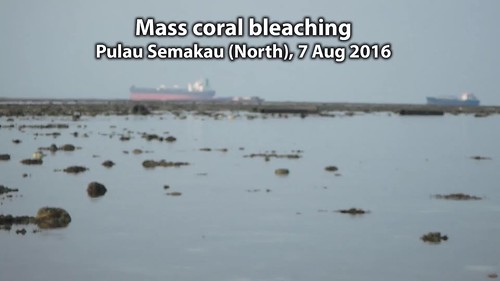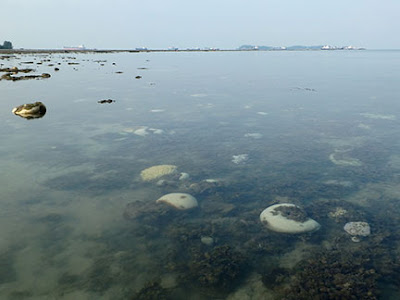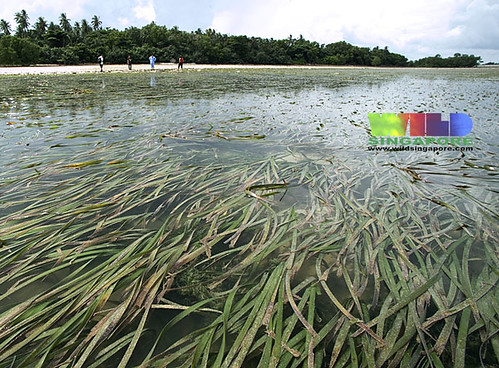I estimate about 30-40% of the hard corals are bleaching. I saw a few small leathery soft corals and about 30% of them were bleaching. I estimate 20% of the corals have died recently. We also failed to find the Fluted giant clam.
Here's a clip of mass coral bleaching on Pulau Semakau (North). Mass coral bleaching is also happening on Terumbu Raya just across the channel.
Shouldn't mass coral bleaching in Singapore be ending? From the NOAA's coral reef watch satellite monitoring, Singapore is in the blue Watch zone. But our corals are still bleaching.
What is coral bleaching?
Coral are colonies of tiny animals called polyps. Each polyp lives inside a little hard skeleton. The huge colony is made up of the skeletons of countless polyps. The polyps of all reef-building hard corals harbour microscopic, single-celled algae (called zooxanthellae). The polyp provides the zooxanthellae with shelter and minerals. The zooxanthellae carry out photosynthesis inside the polyp and share the food produced with the polyp. Corals generally have white colour skeletons, which is believed to assist in photosynthesis by reflecting light onto the zooxanthellae.
Coral are colonies of tiny animals called polyps. Each polyp lives inside a little hard skeleton. The huge colony is made up of the skeletons of countless polyps. The polyps of all reef-building hard corals harbour microscopic, single-celled algae (called zooxanthellae). The polyp provides the zooxanthellae with shelter and minerals. The zooxanthellae carry out photosynthesis inside the polyp and share the food produced with the polyp. Corals generally have white colour skeletons, which is believed to assist in photosynthesis by reflecting light onto the zooxanthellae. When there is massive loss of zooxanthellae in a hard coral colony, the polyps become colourless and the underlying white skeleton shows through. Thus patches of the colony appear pale, white or 'bleached'. The polyps are still alive and the hard coral is not dead (yet).
Hard corals harbouring zooxanthellae live close to the upper limit of temperature tolerance. Thus a temperature increase of even 1-2 degrees centigrade can redust in bleaching. It is believed that global warming will lead to massive bleaching. Once the cause of bleaching is removed, however, polyps may eventually regain zooxanthellae (which live freely in the water) and thus recover their health. But prolonged bleaching can kill corals and seriously damage large sections of a reef.
We last surveyed this shore earlier this year in Apr 2016, when some signs of bleaching were seen, but not mass coral bleaching. Similarly on our survey in Jul 2015, some bleaching but not mass bleaching. Today, I did see some corals that were not bleaching.
Often, bleaching and bleaching corals found next to one another. Many of the Circular mushroom corals I saw were bleaching, but the large Tongue mushroom corals nearby were not.
I saw a few small colonies of leathery soft corals and about 30% of them were bleaching.
Sea anemones harbour zooxanthellae and thus can also bleach. I saw several small bleaching Bubble tip sea anemones. I also saw several Frilly sea anemones and only a few were bleaching.
I saw a few Giant carpet anemones, only one was bleaching. Anemonefishes were not obvious in these anemones. We couldn't find the Fluted giant clams that we saw on our trip in Apr 2016.
I did a quick check on the seagrass situation and it's bad. A sparse sprinkling of very short cropped Tape seagrass and virtually no other seagrasses.
This is what this area looked like before the seagrass meadows vanished.
Today, Pei Yan flew the drone again to document the mass coral bleaching and other impacts to this shore. Check out the SG Sea Drone facebook page for the latest video uploads of what we saw.
It is particularly heartbreaking to see the human impact inflicted to this shore which is suffering from seagrass loss and mass coral bleaching. As we approached Pulau Semakau, on its Eastern shore, we saw one small boat with people appearing to prepare to place nets or traps, and another small boat with people on the shore handling a long fishing net. As we landed on the Northern shore, we saw several people removing a long fishing net. Here's a video clip of all these happenings.
Line fishing happens often and in some numbers on the reefs. There was already a small boat with fishing on the bleaching reef when we arrived shortly after sunrise for a low tide. I can imagine there will be more fishing at high tide.
I also removed two fish traps on the intertidal. They had swimming crabs in them which I released.
While there is not much we can do when our corals start bleaching, we can do a lot to stop other stresses that impact our reefs so the corals are in better health and don't succumb after bleaching.
On the way home, I also saw coral bleaching on Terumbu Bukom. Sigh.
High res photos of mass coral bleaching in Singapore for free download on wildsingapore flickr
Pulau Semakau is NOT the same as the Semakau Landfill. The Landfill was created by destroying all of Pulau Saking, and about half of the original Pulau Semakau by building a very long seawall. Fortunately, the landfill was constructed and is managed in such a way that the original mangroves, seagrass meadows and reefs on Pulau Semakau were allowed to remain. The eastern shore of Pulau Semakau is right next to the seawall of the Semakau Landfill, opposite the petrochemical plants on Pulau Bukom.

As the existing half of the Landfill was used up, the Phase 2 of the Landfill was just recently launched. This involved closing the gap of the seawall on the Semakau Landfill, forming one big pool where incinerated ash will be dumped. NEA worked to limit the damage to natural shores during the construction work for this expansion of the landfill.
Photos by others on this trip
- Russel Low on facebook.
Others on this trip: Heng Pei Yan.





















